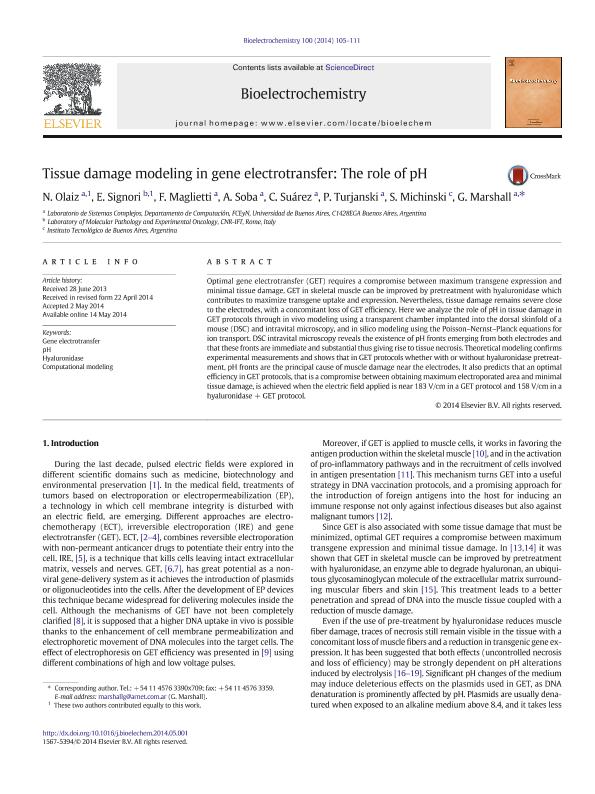Artículo
Tissue damage modeling in gene electrotransfer: the role of pH
Olaiz, Nahuel Manuel ; Signori, Emanuela; Maglietti, Felipe Horacio
; Signori, Emanuela; Maglietti, Felipe Horacio ; Soba, Alejandro
; Soba, Alejandro ; Suárez, Cecilia Ana
; Suárez, Cecilia Ana ; Turjanski, Pablo Guillermo
; Turjanski, Pablo Guillermo ; Michinski, Sebastián Diego
; Michinski, Sebastián Diego ; Marshall, Guillermo Ricardo
; Marshall, Guillermo Ricardo
 ; Signori, Emanuela; Maglietti, Felipe Horacio
; Signori, Emanuela; Maglietti, Felipe Horacio ; Soba, Alejandro
; Soba, Alejandro ; Suárez, Cecilia Ana
; Suárez, Cecilia Ana ; Turjanski, Pablo Guillermo
; Turjanski, Pablo Guillermo ; Michinski, Sebastián Diego
; Michinski, Sebastián Diego ; Marshall, Guillermo Ricardo
; Marshall, Guillermo Ricardo
Fecha de publicación:
12/2014
Editorial:
Elsevier Science
Revista:
Bioelectrochemistry
ISSN:
1567-5394
Idioma:
Inglés
Tipo de recurso:
Artículo publicado
Clasificación temática:
Resumen
Optimal gene electrotransfer (GET) requires a compromise between maximum transgene expression and minimal tissue damage. GET in skeletal muscle can be improved by pretreatment with hyaluronidase which contributes to maximize transgene uptake and expression. Nevertheless, tissue damage remains severe close to the electrodes, with a concomitant loss of GET efficiency. Here we analyze the role of pH in tissue damage in GET protocols through in vivo modeling using a transparent chamber implanted into the dorsal skinfold of a mouse (DSC) and intravital microscopy, and in silico modeling using the Poisson–Nernst–Planck equations for ion transport. DSC intravital microscopy reveals the existence of pH fronts emerging from both electrodes and that these fronts are immediate and substantial thus giving rise to tissue necrosis. Theoretical modeling confirms experimental measurements and shows that in GET protocols whether with or without hyaluronidase pretreatment, pH fronts are the principal cause of muscle damage near the electrodes. It also predicts that an optimal efficiency in GET protocols, that is a compromise between obtaining maximum electroporated area and minimal tissue damage, is achieved when the electric field applied is near 183 V/cm in a GET protocol and 158 V/cm in a hyaluronidase + GET protocol.
Palabras clave:
Gene Electrotransfer
,
Ph
,
Hyaluronidase
,
Computational Modeling
Archivos asociados
Licencia
Identificadores
Colecciones
Articulos(INFINA)
Articulos de INST.DE FISICA DEL PLASMA
Articulos de INST.DE FISICA DEL PLASMA
Articulos(SEDE CENTRAL)
Articulos de SEDE CENTRAL
Articulos de SEDE CENTRAL
Citación
Olaiz, Nahuel Manuel; Signori, Emanuela; Maglietti, Felipe Horacio; Soba, Alejandro; Suárez, Cecilia Ana; et al.; Tissue damage modeling in gene electrotransfer: the role of pH; Elsevier Science; Bioelectrochemistry; 100; 12-2014; 105-111
Compartir
Altmétricas



